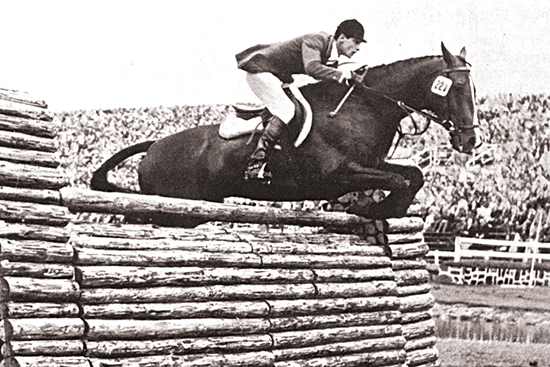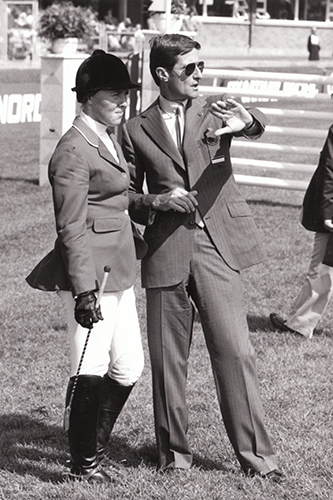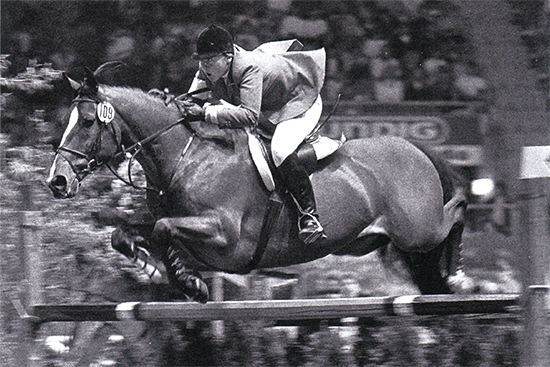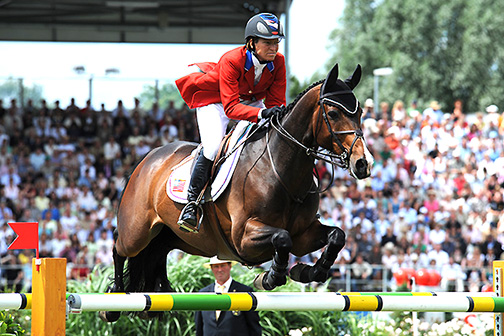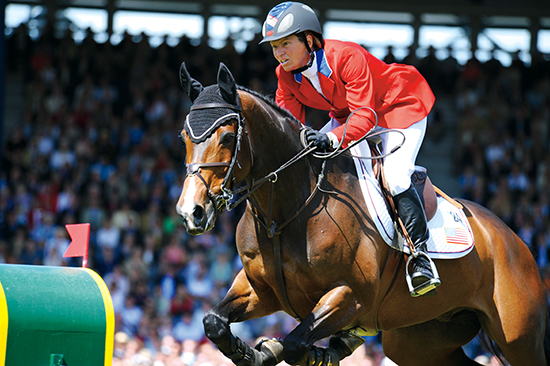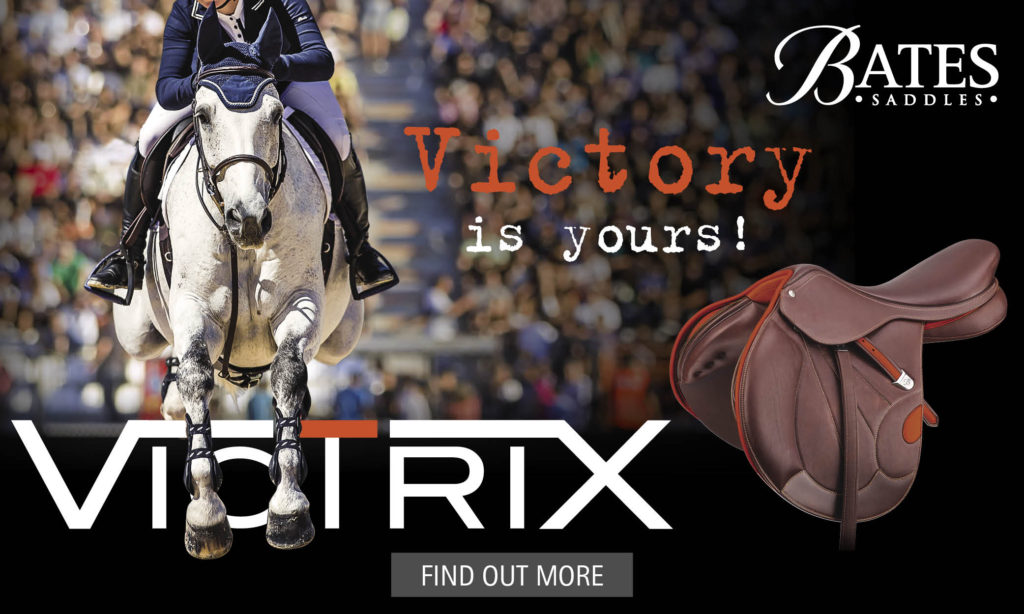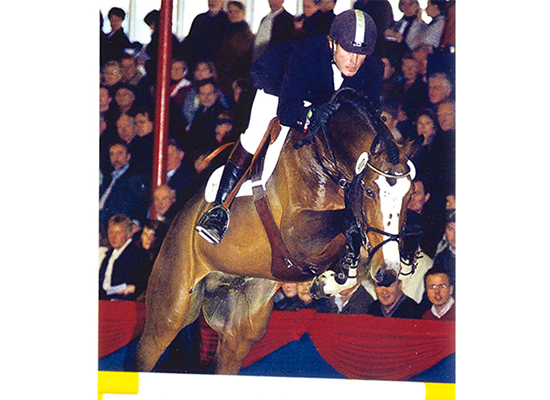One of the intriguing things about the equestrian tradition, is how much of it is handed on from generation to generation by gifted horsemen, developing and becoming richer in the process. Back in 2008, we talked to George Morris and asked him:
But is the sport better?
Aachen in the old days, going through the water as well as jumping it…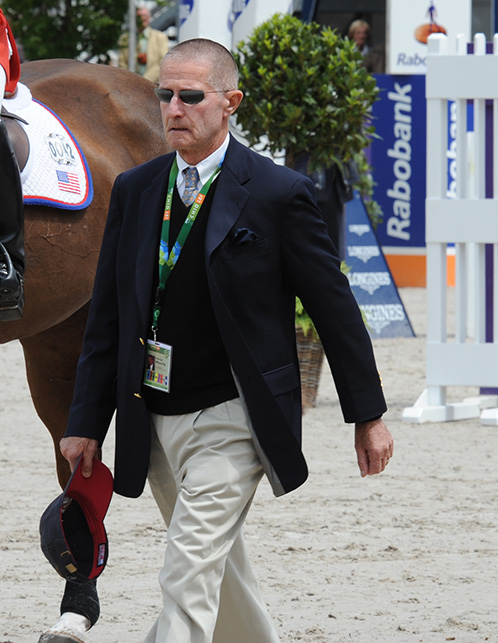
“Of course lots is better, much is quicker, and of course you could write a thesis on what was better, what is better, what could be better – yes, the sport has lost a lot, but the sport gained a lot.”
The Aachen hedges in 2004
“What it has lost the most to me is time. We used to have time for our horse, we used to have time at home, at horse shows, which were great social gatherings. There isn’t now the time, and that colours everything that happens with a horse, and with a horse show. Time and space – my sport of jumping is taking the country to an arena, and you take away time and space and the space gets smaller and tighter and the time gets quicker, there isn’t time to manicure and manage natural fences. Natural fences present an unexpected problem to a horse that hasn’t been given time in his schooling to learn to deal with them. That’s our biggest enemy now, time and space.”
George Morris and Night Owl at Aachen 1960, when the fences were natural
The horses have changed a lot – I was talking to Melanie Smith Taylor about the almost total domination of the sport by European Warmbloods…
“Everything has become universal. Universal riding style, universal training, universal horses, universal courses, it is a very much smaller world, and what has happened to the horse is that it is the American Thoroughbred with substance and scope, and the European horse with Thoroughbred refinement – it’s one horse now, and you don’t see the differentiation. Even if you saw a Thoroughbred horse now, it would be a boned horse, or if you see a Holsteiner, it is a blood horse. It is the universal horse but that has happened because the world has shrunk. This Brazilian helps that French girl, that German helps that American rider, it is one much tighter smaller family. In my day, the Chileans were a force to be reckoned with, in the early thirties, the Japanese won the gold medal in jumping. It was very separate and very distant, very individualistic. In a very funny way there was more universality in those days than these days. Lots of things are different, but as we say, everything changes but everything remains the same…”
When you went looking for horses in Europe in the 70’s and bought Calypso, were you looking for a European horse that looked more like the Thoroughbreds you had grown up with?
“Yes, we always gravitated – as you did in Australian and New Zealand – to the Thoroughbred horse. I really was the first person in the very late 70s with Melanie Smith that really started that ball rolling. The odd horse had come over from Europe by accident, but it was an odd event. We were in Aachen, I had Melanie Smith and Michael Matz, two individuals, and we bought a wonderful horse from a Spanish rider, Val de la Loire. At Aachen I bumped into an old Dutch dressage trainer, Harry Hillhice, who I’d grown up with in the United States, he was a professional dressage trainer in the United States, training ladies, early early on at Oxbridge. At Aachen he said, ‘George, I want to show you a couple of horses, they are a very short distance away. We’ll have dinner and bring you back by 10 or 11 o’clock. We went with Harry, I got into the beer – which in those days I did more than I do now – and got very tipsy very quickly.”
Melanie Smith and George Morris went looking to find horses in Europe and discovered a super-star, World Cup Champion – Calypso
“We looked at a little horse, he must have been 15.3, a little stallion, Vivaldi, and I convinced Melanie and her mother and the owners to buy this little speed horse. He wasn’t very expensive, he wasn’t very big, but I loved the horse. I woke up the next morning and said to Melanie ‘What did I do?’ Luckily this little Vivaldi turned out to be a world beater as a speed horse – a metre forty maximum. That horse led Melanie, and Neil Eustice, who was her owner at the time, to re-contact Harry Hillhice.”
“I wasn’t there at the time, I was in America giving a clinic, and I think Neil Eustace was on an antique trip or something, and he called Harry who said ‘I have a horse for you.’ I wasn’t there, Melanie wasn’t there, she was the demonstrator at a clinic of mine in Kentucky. They looked at the horse, and the owner, Neil Eustace was a great guy, I wouldn’t say a horseman particularly, but he looked at the horse in the stall, and bought the horse. I said to Melanie, you have to ride the horse, you have to get over there and sit on that horse, because it could be dangerous to your health if it is not a good jumper. She jumped on an airplane, got there and loved the horse. So they bought Calypso.”
“By early 1978, the ball was rolling in America for the European horse. The Americans fell in love with Calypso, they liked Val de la Loire and Vivaldi, but the horse America fell in love with was Calypso. In the late 70s I bought another Dutch horse, Olympus, also by Lucky Boy, and he was a very handsome horse – more of a half bred type, and I was one of the first to show a European horse in the Hunter division, and he was never first, and he was never fourth, he was always second or third. Now all the Hunters are European. That was the tipping point, 77, 78, with those Dutch horses.”
But Vivaldi and Calypso were by Lucky Boy, a Thoroughbred stallion… were you deliberately looking for European horses that looked more like the horses you were used to seeing?
“Even today when I look at horses in Europe, I gravitate intuitively and instinctively towards the Thoroughbred horse, that’s our base, that’s our background, that’s our upbringing – so they bring out horse after horse after horse, I say ‘that one’ because that’s the blood horse. The big footed, straight pasterned, no wither, clunker, I say ‘ I don’t want to see that one…’”
Beezie Madden, George describes her as a ‘giant talent’
What was Calypso’s big strength?
“Actually when she got him home to Connecticut, I went up to see Calypso, and I said, I liked his bounce. He’s not a big horse, I like his type, he was a pony type, but a Thoroughbred pony type, and he wasn’t particularly good in front. I was suspicious of him up there, but once Melanie got him to Florida and she entered him in the first preliminary – the class preparatory to open jumpers, he was a winner. He was very very fast, he was very careful, he had sufficient scope, although he was the type, you didn’t know if he had Olympic scope, or World Cup scope, until he did it, but he won me very quickly. The initial impression was that I wasn’t crazy about his front end.”
You worked on that front end technique?
“No no, in my system we don’t work on a horse’s front end. A horse jumps with a style, that will get better, that will get worse, that will maintain. If well ridden, consistently ridden, gymnastic jumping, course jumping, it takes care of itself, or it doesn’t take care of itself. God made that – and this horse being very very intelligent, that style got better. If that horse was a chicken or stupid, that style would have got worse. You can’t fix that. That horse just got better, he was a very smart horse, he was just a winner. He hated to touch fences.”
You were talking about your admiration for Gerd Heuschmann, do you think it is time for all the equestrian sports to take a step back and look hard at how horse friendly the training methods are?
“I am very critical myself of the way people walk, trot, canter horses, even riders who are great over fences, who have a knack for jumping, I am often critical of their flat work. I was educated by icons – Richard Wätjen, a German icon before the War, taught me. Bert de Nemethy, an icon for all the world, taught me. Gunnar Andersen was my last teacher – the great Danish man that even the Germans bowed to. I never had lesser teachers so I was taught the difference very early, and that makes it very difficult for me to look at lots of riders. I’m not saying I am better than they are, just that I was very well-educated to what was correct for the physical and mental apparatus of the horse.”
“What they taught me has always stood me in good stead. It’s worked for me and my students. I first saw Gerd Heuschmann’s book reviewed in your magazine, which I always read, and I don’t read many magazines. I read that very thoroughly and I was very intrigued and I loved it. Very quickly I got a copy of the book, and while I’m not a vet and some of it was very vet orientated, I was in total agreement with the whole book. If I am in total agreement with some horse literature, I say – yes. If it is something that that contradicts what I really believe inside, I say – no. This book, cover to cover, I said yes, yes, yes. He’s writing and taking pictures of what I’m thinking. We have to take a really hard look at what we are doing physically to horses, and what we are doing to horses mentally.”
“Basics are basics are basics – the horse has to properly work his body, and at the same time properly working a horse physically works him properly mentally. You can change horses over time, amazingly – it’s impossible to make a bad horse a good horse, you can make an adequate horse a pretty decent horse, you can make a good horse a very good horse, you can maintain a great horse so he doesn’t slip. Anyone can ruin a horse in a heart beat… and what is happening is this vicious circle of working incorrectly, veterinary need, working incorrectly, more veterinary maintenance, that’s a vicious circle.”
“I don’t remember with de Nemethy, lame horses. I don’t remember with de Nemethy, vets around the clock. In the 50s and 60s I don’t remember missing horse shows because of veterinary problems. Yes, we had the great vet, Danny Marks at a Championship, but we didn’t have vets in residence, we didn’t have injections maintaining, maintaining, maintaining, maintaining. I personally have never used massage or acupunture – I’m not saying it’s wrong – but I exercise my body, and I think that’s how to deal with animals – to properly exercise their bodies on a daily basis. I have great friends who are vets, and I respect vets, but I think this obsession with vets, is preceded by incorrect riding.”
It was lovely at Rotterdam watching Beezie Madden warm up her horses – it was just so uncomplicated, so forward, and yet she was doing some quite complicated lateral work at the same time…
“Because it is simple. The classicists from Xenophon through the Renaissance to France, to Italy, to Germany, they were brilliant. Imagine people inventing the impression of impulsion, the exactness of straightness, imagine inventing half pass, piaffe, passage, all the classical movements that make the horse better to ride. The classicists taught us the rules centuries ago, and I am very reluctant to go off the track of these rules. As a rider and a horseman, every day here at Aachen, I have ridden Beezie’s horses, and Beezie has such a fabulous attitude, she is so humble that she watches what I do with her horses – Beezie Patton Madden, who won the Grand Prix of Aachen last year. I don’t stray. I’m not saying I am Reiner Klimke, or Ludger Beerbaum or Bill Steinkraus, I never was that talent, but I don’t like to stray from what the classicists taught us.”
But you worry at some of the new techniques, the technique of hyperflexion…
“The Masters from the very beginning taught us there were two types of flexions. The first is lateral, where the horse turns his head slightly, yields his jaw to one rein. The second is direct flexion where the neck is straight and the horse yields his lower jaw to both reins. This flexion, especially this lateral flexion, is a very good technique because it relaxes the jaw, which in turn bends the poll which is a seat for resistance in the horse. Ancient classical principle, flexion de la bouche – the problem is that some of today’s riders took that great technique to an extreme, so that it has become a defect. That happens with every technique… Bill Steinkraus said to me, ‘We invented the crest release, now I bet you wish you hadn’t…”
You are still riding horses here at Aachen…
“Beezie lets me ride them because she has a lot of horses here. I ask her, and she lets me, and I think she likes it. I do it at home too, with Laura Kraut and different people. Beezie has a very big day because she has four horses here at Aachen and a lot of classes, so to help her get through the day, I ride one a day. She watches and she is still learning from what I am doing with her horse. I’m now 70, this is my 50th year of riding a horse at Aachen. Still every step I am on a horse, I’m thinking about what is happening with the horse, what I am doing, what could be better, where is there resistance, how to break up the resistance. It’s not that I am hacking the horse, I’m a very intellectual rider because that is the only way I made it. I am not a natural confident rider, so I had to make it by brains. I have to bring Meredith Michaels into that whole idea, because Meredith was always very gutsy against the clock but Meredith had to work at it, and Meredith was always very very smart, and that’s her greatest asset. People ask what’s your most important aid on a horse? Some say seat, some say leg, some say hand – no, it’s your brain. That is Meredith Michaels-Beerbaum’s greatest asset, she is very very smart. She went to Princeton, and that’s no easy thing to do. That’s how I ride a horse, by thinking. Every second I am with a horse, I am thinking…”
You said that the great horses were God given, does God make the Beezie Maddens – was she like that when you first met her?
“Beezie Madden always had a giant talent. She’s got everything, giant talent, an emotion that never quits, cool as a cucumber, like Meredith, she’s super intelligent, she is very to herself in her work. She rides any any any horse, and she is respected around the world by the top men, she can ride any horse. She is very special.”
And George Morris is very very special: A horseman and a thinker. The sport of jumping may be better in some respects, worse in others, but it is very much the better for the contribution of George Morris. Long may he continue to influence its development.
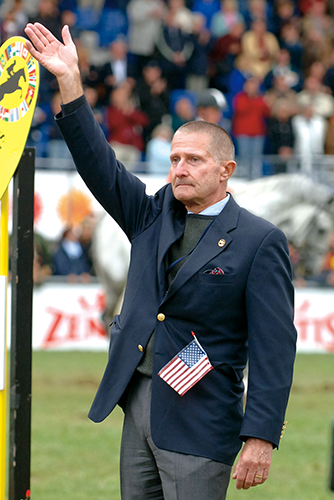
Breeding a jumper in Australia? Go to www.ihb.com.au and select a stallion – like Balou du Rouet…
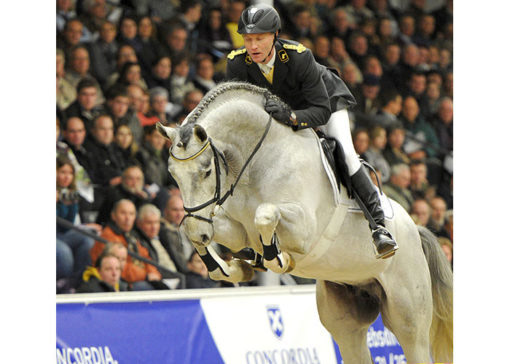
Or Grey Top
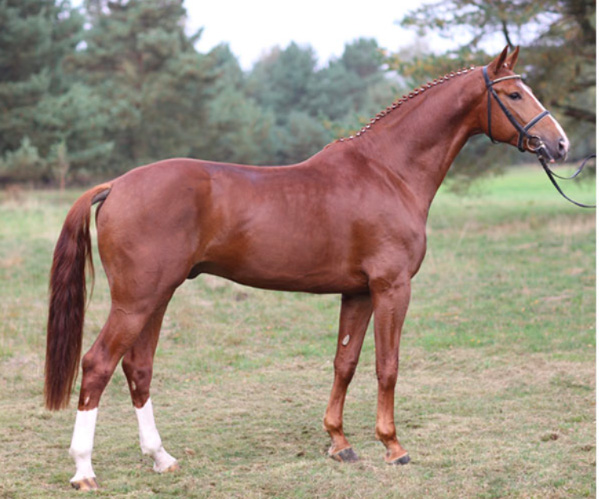
Or Edward, sire of King Edward




